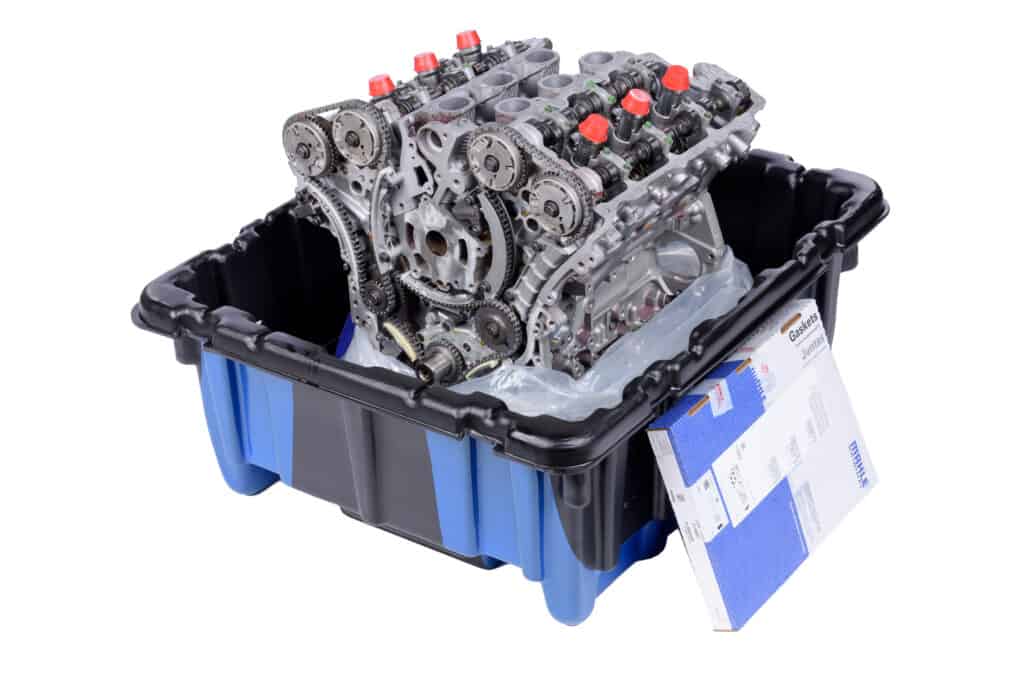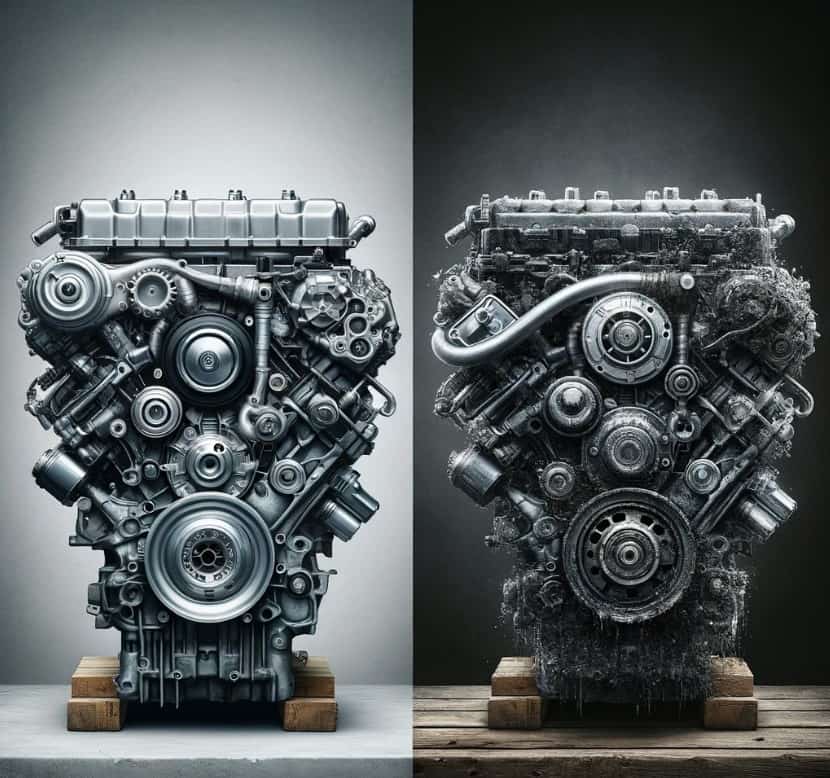Remanufactured Engines for Sale
What is a re-manufactured engine?
A re-manufactured engine, often referred to as a “reman” engine, is essentially a used engine that has been completely taken apart, inspected, cleaned, and then rebuilt with new or reconditioned components to bring it back to its original manufacturing specifications or better. The process typically involves the following steps:
Disassembly: The entire engine is dismantled piece by piece. Every component is inspected carefully.
Cleaning and Inspection: All parts are cleaned thoroughly. This includes removing old gaskets, carbon deposits, and other residues. The parts are then inspected for wear, damage, or defects.
Machining and Reconditioning: Key components such as the cylinder head, block, crankshaft, and connecting rods may be machined to restore their dimensions or surface finish. Some parts may be straightened, welded, or otherwise reconditioned.
Replacement of Worn Parts: Any parts that are too worn or damaged are replaced with new ones. This includes critical parts like bearings, gaskets, seals, and often the pistons.
Reassembly: The engine is carefully reassembled with the new and reconditioned parts, ensuring that everything meets the original equipment manufacturer’s (OEM) specifications.
Testing: The re-manufactured engine is usually tested for leaks, compression, and overall performance to ensure it meets or exceeds original performance specifications.
The advantage of a re-manufactured engine is that it should be as reliable as a new engine but typically costs less. It’s also an environmentally friendly option as it recycles much of the existing engine. These engines often come with warranties, making them a viable alternative for extending the life of a vehicle without the expense of buying a new one.

Why choose a re-manufactured engine over a used engine?
Choosing a re-manufactured engine over a used engine involves considering factors such as reliability, warranty, environmental impact, and overall value. Here are the key reasons why a re-manufactured engine might be a better choice:
Quality and Reliability: Re-manufactured engines are disassembled, cleaned, inspected, and rebuilt with new or reconditioned parts. This process ensures that they meet or exceed the original equipment manufacturer’s (OEM) specifications. In contrast, used engines are typically sold as-is from another vehicle without extensive rebuilding or testing, meaning their reliability can be uncertain.
Warranty Coverage: Re-manufactured engines often come with warranties, similar to new engines, offering peace of mind and protection against defects. Used engines, however, generally have limited or no warranty, posing a risk in case of early failure.
Cost-Effectiveness: Although re-manufactured engines might be more expensive than used engines upfront, their reliability and warranty coverage can make them more cost-effective in the long run. The reduced likelihood of needing future repairs can offset the initial higher cost.
Environmental Benefits: Re-manufacturing engines is an environmentally friendly option as it recycles a significant portion of an existing engine, reducing waste and the need for new materials. This contrasts with used engines, which don’t necessarily reduce environmental impact.
Performance: Re-manufactured engines are built to OEM specifications, which can result in performance that is equivalent to or better than that of the original engine. Used engines may have varying degrees of wear and tear, potentially affecting their performance.
Customization: Some re-manufacturers offer customization options for specific performance needs, something that is typically not available with used engines.
Availability and Convenience: Re-manufactured engines are readily available for a wide range of vehicle makes and models. Additionally, purchasing a re-manufactured engine is often a quicker process than finding a used engine with the desired quality and mileage.
In summary, while used engines can be a more budget-friendly option upfront, re-manufactured engines provide a balance of reliability, warranty protection, environmental friendliness, and overall value, making them a compelling choice for many vehicle owners.

What is the difference between a re-manufactured engine and a crate engine?
The difference between a re-manufactured engine and a crate engine lies primarily in their condition, origin, and intended use. Here’s a detailed comparison:
Origin and Condition:
- Re-manufactured Engine: This is an engine that has been previously used and then completely disassembled, inspected, and rebuilt. Any worn or damaged parts are replaced with new or reconditioned parts. The goal is to restore the engine to its original performance specifications or better.
- Crate Engine: A crate engine is a brand new engine that is delivered to the buyer in a crate, hence the name. These engines are typically either OEM (original equipment manufacturer) engines or high-performance aftermarket engines. They have never been used in a vehicle before.
Components and Assembly:
- Re-manufactured Engine: It may include a mix of reused, reconditioned, and new components. The re-manufacturing process aims to bring the engine back to OEM standards.
- Crate Engine: Comes complete and ready to install. It includes all new components and is often fully assembled, although there are also “short block” or “long block” options with varying degrees of assembly.
Performance:
- Re-manufactured Engine: Designed to match the performance of the original engine. It’s a like-for-like replacement, aiming to deliver factory-spec performance.
- Crate Engine: Can range from standard factory-spec engines to high-performance models. Crate engines are popular in the auto performance and racing world, as they can offer increased power and efficiency.
Cost:
- Re-manufactured Engine: Generally, more cost-effective than buying a new crate engine. The use of reconditioned parts helps to lower the price.
- Crate Engine: More expensive due to being completely new, especially for high-performance models. However, they offer the reliability and peace of mind of a new product.
Warranty and Reliability:
- Re-manufactured Engine: Typically comes with a warranty, though the length and coverage may vary. The reliability is high, assuming it’s re-manufactured to OEM standards.
- Crate Engine: Usually comes with a more extensive warranty as it’s a new product. Reliability is expected to be very high.
Environmental Impact:
- Re-manufactured Engine: More environmentally friendly as it reuses and recycles many parts of an existing engine.
- Crate Engine: While it’s a new product requiring new resources, advancements in engine technology can sometimes offer better fuel efficiency and lower emissions compared to older engines.
In summary, a re-manufactured engine is a cost-effective, eco-friendly choice for replacing an old engine to its original condition, while a crate engine is a brand new, potentially high-performance option for those looking for an upgrade or building a custom vehicle.
What is the difference between a re-manufactured engine and a re-built engine?
The difference between a re-manufactured engine and a rebuilt engine lies primarily in the extent of the work done, the standardization of the process, and the overall quality and reliability of the final product. Here’s a breakdown of the key differences:
Process and Extent of Work:
- Re-manufactured Engine: This involves a comprehensive process where the engine is completely disassembled, cleaned, and inspected. All worn or outdated parts are replaced with new or reconditioned components. The engine is then reassembled to meet or exceed the original manufacturer’s specifications. This process is often carried out in a factory setting using advanced machinery and technology.
- Rebuilt Engine: Rebuilding an engine generally involves less comprehensive work. It involves taking apart the engine, identifying damaged or worn parts, and replacing them. The extent of rebuilding can vary significantly depending on the condition of the engine and the discretion of the mechanic. Not all components may be addressed if they are deemed to be in satisfactory condition.
Standardization and Quality Control:
- Re-manufactured Engine: There is a higher level of standardization. The process is usually carried out in a controlled environment following strict industry standards, ensuring that the re-manufactured engines are consistent in quality.
- Rebuilt Engine: The quality can vary greatly depending on who is doing the rebuilding and their skill level. There is no industry standard for rebuilding, so two rebuilt engines can differ significantly in terms of work quality and the parts used.
Warranty and Reliability:
- Re-manufactured Engine: Generally comes with a longer warranty, similar to a new engine. This is due to the thorough process and adherence to OEM specifications, which often results in a more reliable end product.
- Rebuilt Engine: Warranties for rebuilt engines are typically shorter and less comprehensive. The reliability can vary, depending on the quality of the rebuild and the parts used.
Cost:
- Re-manufactured Engine: Tends to be more expensive than a rebuilt engine due to the more extensive work and the use of new or reconditioned parts.
- Rebuilt Engine: Usually less expensive than re-manufactured engines as the process is less comprehensive and may involve fewer new parts.
Environmental Impact:
- Re-manufactured Engine: Both re-manufacturing and rebuilding are more environmentally friendly than producing a new engine, but re-manufacturing is often more so because it is more standardized and comprehensive, often resulting in a longer-lasting product.
- Rebuilt Engine: Also eco-friendly compared to new engines, but the variability in the rebuilding process can affect the longevity and efficiency of the engine.
In summary, while both re-manufactured and rebuilt engines are cost-effective alternatives to buying a new engine, a re-manufactured engine typically offers a higher level of reliability and performance, akin to a new engine, due to the thoroughness of the re-manufacturing process and adherence to OEM specifications.
What are the benefits of putting a re-manufactured engine in my vehicle as apposed to just getting a used car?
Choosing to install a re-manufactured engine in your vehicle instead of purchasing a used car comes with several benefits, especially if you are attached to your current vehicle or it has specific value to you. Here are the key advantages:
Cost-Effectiveness: Generally, putting a re-manufactured engine in your existing vehicle can be more cost-effective than buying a used car. The overall investment is often lower, especially when considering the unknowns associated with a used car, such as its maintenance history and potential hidden problems.
Known Vehicle History: With your current vehicle, you have a clear history of its maintenance and any issues it may have had. In contrast, a used car can come with uncertainties regarding its past care and usage, which can potentially lead to unforeseen expenses and problems.
Reliability: A re-manufactured engine is rebuilt to meet or exceed original manufacturer specifications and often comes with a warranty. This means you’re essentially getting an engine that’s in ‘like new’ condition, providing a level of reliability that may not be guaranteed with a used car.
Environmental Considerations: Re-manufacturing engines is an environmentally friendly process as it reuses existing materials and components, thereby reducing waste and the need for new resources. In comparison, the process of manufacturing a new car, even a used one, has a significant environmental impact.
Preservation of Your Current Vehicle: If your vehicle has sentimental value, rare features, custom modifications, or is a classic car, maintaining it with a re-manufactured engine allows you to preserve these unique aspects. With a used car, you would have to start from scratch in terms of customization and building familiarity.
Avoidance of Additional Expenses: Buying a used car often involves additional expenses such as taxes, registration, and insurance changes. By keeping your current vehicle and replacing its engine, you avoid many of these extra costs.
Potential for Improved Performance: A re-manufactured engine can sometimes offer better performance and efficiency compared to your old engine, especially if it has been upgraded or improved during the re-manufacturing process.
Warranty Coverage: Re-manufactured engines typically come with warranties that provide an added layer of financial security and peace of mind. Warranties on used cars, especially older models, may be limited or nonexistent.
Customization and Upgrades: Depending on your choice of re-manufactured engine, there can be options for customization or choosing an engine with better performance characteristics than your original engine.
Convenience: Dealing with engine replacement can sometimes be more straightforward than the process of shopping for, purchasing, and acclimating to a different used car.
In summary, installing a re-manufactured engine in your vehicle can be a wise decision if you’re looking for a cost-effective, reliable, and environmentally friendly solution, especially if you’re attached to your current vehicle for practical or sentimental reasons.
